Assessing Utilization and Comfort in a Village Scenic Park: Implications for Rural Revitalization
Abstract
1. Introduction
1.1. Background
1.2. Research Aim
2. Material and Methods
2.1. Research Area
2.2. Methods
2.2.1. Satisfaction Survey
2.2.2. Accessibility Analysis
2.2.3. Comfort Analysis
3. Results
3.1. Both Villagers and Tourists Are Generally Satisfied with the Scenic Park
3.2. The Scenic Park Is Located in the Most Accessible Area within the Village
3.3. The Scenic Park Is also the Best Choice for Cooling down during the Hottest Summer Day
4. Discussion
4.1. The Implications for Daily Life
“It’s not that we are opposed to visitors coming to rest; we welcome them. But conversations with tourists are limited due to language barriers. While we might answer their questions as best as we can, communication can be challenging. We primarily speak our local dialect, which many tourists do not understand.”(Bi, aged 61 and above)
“We do visit the art museum, but we admit that we don’t fully understand art. The COVID-19 pandemic had led to strict controls in the village, and as a result, there had been few visitors. Now that COVID-19 has ended, we hope that more young people will come here in the future.”(Wang, aged 51–60)
4.2. The Implications for Rural Revitalization
5. Conclusions
Author Contributions
Funding
Data Availability Statement
Acknowledgments
Conflicts of Interest
References
- Banwell, K.; Kingham, S. Living well in your local neighbourhood: The value of bumping and gathering places. Wellbeing Space Soc. 2023, 4, 100124. [Google Scholar] [CrossRef]
- Edge, S.; Davis, C.; Dean, J.; Onilude, Y.; Rishworth, A.; Wilson, K. The role of urban and rural greenspaces in shaping immigrant wellbeing and settlement in place. Wellbeing Space Soc. 2023, 4, 100124. [Google Scholar] [CrossRef]
- Yung, E.H.K.; Wang, S.; Chau, C.-K. Thermal perceptions of the elderly, use patterns and satisfaction with open space. Landsc. Urban Plan. 2019, 185, 44–60. [Google Scholar] [CrossRef]
- Zhang, X.; Warner, M.E.; Wethington, E. Can Age-Friendly Planning Promote Equity in Community Health Across the Rural-Urban Divide in the US? Int. J. Environ. Res. Public Health 2020, 17, 1275. [Google Scholar] [CrossRef] [PubMed]
- Wu, W.; Zhang, M.; Qing, Y.; Li, Y. Village resettlement and social relations in transition: The case of Suzhou, China. Int. Dev. Plan. Rev. 2019, 41, 269–291. [Google Scholar] [CrossRef]
- Suckall, N.; Fraser, E.D.; Cooper, T.; Quinn, C. Visitor perceptions of rural landscapes: A case study in the Peak District National Park, England. J. Environ. Manag. 2009, 90, 1195–1203. [Google Scholar] [CrossRef] [PubMed]
- Balta, S.; Atik, M. Rural planning guidelines for urban-rural transition zones as a tool for the protection of rural landscape characters and retaining urban sprawl: Antalya case from Mediterranean. Land Use Policy 2022, 119, 106144. [Google Scholar] [CrossRef]
- Xie, X.; Wang, R.; Gou, Z. Changes in park visits and the shift towards rural recreation: Evidence from the COVID-19 pandemic in the UK. J. Rural. Stud. 2024, 106, 103221. [Google Scholar] [CrossRef]
- Qu, M.; Zollet, S. Neo-endogenous revitalisation: Enhancing community resilience through art tourism and rural entrepreneurship. J. Rural. Stud. 2023, 97, 105–114. [Google Scholar] [CrossRef]
- Šťastná, M.; Vaishar, A. Values of rural landscape: The case study Chlum u Třeboně (Bohemia). Land Use Policy 2020, 97, 104699. [Google Scholar] [CrossRef]
- Sutherland, L.-A. Horsification: Embodied gentrification in rural landscapes. Geoforum 2021, 126, 37–47. [Google Scholar] [CrossRef]
- Vaishar, A.; Šťastná, M. Impact of the COVID-19 pandemic on rural tourism in Czechia Preliminary considerations. Curr. Issues Tour. 2022, 25, 187–191. [Google Scholar] [CrossRef]
- Cheung, P.K.; Jim, C. Subjective outdoor thermal comfort and urban green space usage in humid-subtropical Hong Kong. Energy Build. 2018, 173, 150–162. [Google Scholar] [CrossRef]
- Lai, D.; Liu, W.; Gan, T.; Liu, K.; Chen, Q. A review of mitigating strategies to improve the thermal environment and thermal comfort in urban outdoor spaces. Sci. Total. Environ. 2019, 661, 337–353. [Google Scholar] [CrossRef] [PubMed]
- Zhang, X.; Li, H.; Jian, Y.; Fu, H.; Wang, Z.; Xu, M. Vernacular or modern: Transitional preferences of residents living in varied stages of urbanisation regarding rural landscape features. J. Rural. Stud. 2022, 95, 95–108. [Google Scholar] [CrossRef]
- Nam, M.; Kim, I.; Hwang, J. Can Local People Help Enhance Tourists’ Destination Loyalty? A Relational Perspective. J. Travel Tour. Mark. 2016, 33, 702–716. [Google Scholar] [CrossRef]
- Dong, H.; Chen, Y.; Huang, X. A new framework for analysis of the spatial patterns of 15-minute neighbourhood green space to enhance carbon sequestration performance: A case study in Nanjing, China. Ecol. Indic. 2023, 156, 111196. [Google Scholar] [CrossRef]
- Wang, G.; LiuPing, D.; Jing, L. A study on the cognition of the regional types of rural revitalization from the perspective of land planning. J. King Saud. Univ. Sci. 2023, 35, 1023532. [Google Scholar] [CrossRef]
- Wang, J.; Sun, Q.; Zou, L. Spatial-temporal evolution and driving mechanism of rural production-living-ecological space in Pingtan islands, China. Habitat Int. 2023, 137, 102833. [Google Scholar] [CrossRef]
- GB/T 37072-2018; Evaluation for the Construction of Beautiful Villages. State Administration for Market Regulation, Standardization Administration of the China: Beijing, China, 2018.
- Hunter, R.; Cleland, C.; Cleary, A.; Droomers, M.; Wheeler, B.; Sinnett, D.; Nieuwenhuijsen, M.; Braubach, M. Environmental, health, wellbeing, social and equity effects of urban green space interventions: A meta-narrative evidence synthesis. Environ. Int. 2019, 130, 104923. [Google Scholar] [CrossRef]
- Browning, M.H.E.M.; Hanley, J.R.; Bailey, C.R.; Beatley, T.; Gailey, S.; Hipp, J.A.; Larson, L.R.; James, P.; Jennings, V.; Jimenez, M.P.; et al. Quantifying Nature: Introducing NatureScoreTM and NatureDoseTM as Health Analysis and Promotion Tools. Am. J. Health Promot. 2024, 38, 126–134. [Google Scholar] [CrossRef] [PubMed]
- Beatley, T. Biophilic Cities and Healthy Societies. Urban Plan. 2017, 2, 1–4. [Google Scholar] [CrossRef]
- McDonald, R.I.; Aronson, M.F.J.; Beatley, T.; Beller, E.; Bazo, M.; Grossinger, R.; Jessup, K.; Mansur, A.V.; de Oliveira, J.A.P.; Panlasigui, S.; et al. Denser and greener cities: Green interventions to achieve both urban density and nature. People Nat. 2023, 5, 84–102. [Google Scholar] [CrossRef]
- Beatley, T. Biophilic Cities and Urban Resilience. In Handbook of Biophilic City Planning and Design; Island Press/Center for Resource Economics: Washington, DC, USA, 2016; pp. 41–48. [Google Scholar] [CrossRef]
- Pearce, C.; Tilley, S.; Thompson, C.W. ‘Being there’ is what matters: Methodological and ethical challenges when undertaking research on the outdoor environment with older people during and beyond the COVID-19 pandemic. SSM Qual. Res. Health 2023, 4, 100348. [Google Scholar] [CrossRef]
- Cherrie, M.P.C.; Shortt, N.K.; Mitchell, R.J.; Taylor, A.M.; Redmond, P.; Thompson, C.W.; Starr, J.M.; Deary, I.J.; Pearce, J.R. Green space and cognitive ageing: A retrospective life course analysis in the Lothian Birth Cohort 1936. Soc. Sci. Med. 2018, 196, 56–65. [Google Scholar] [CrossRef] [PubMed]
- Yang, B.; Hong, B. Pocket park in urban regeneration of China: Policy and perspective. City Environ. Interact. 2023, 19, 100109. [Google Scholar] [CrossRef]
- Kerishnan, P.B.; Maruthaveeran, S. Factors contributing to the usage of pocket parks―A review of the evidence. Urban For. Urban Green. 2021, 58, 126985. [Google Scholar] [CrossRef]
- Du, C.; Jia, W.; Wang, K. Valuing carbon saving potential of urban parks in thermal mitigation: Linking accumulative and accessibility perspectives. Urban Clim. 2023, 51, 5101645. [Google Scholar] [CrossRef]
- Shadman, S.; Khalid, P.A.; Hanafiah, M.M.; Koyande, A.K.; Islam, A.; Bhuiyan, S.A.; Kok, S.W.; Show, P.-L. The carbon sequestration potential of urban public parks of densely populated cities to improve environmental sustainability. Sustain. Energy Technol. Assess. 2022, 52, 102064. [Google Scholar] [CrossRef]
- Arvanitidis, P.; Lalenis, K.; Artopoulos, G.; Pallares-Barbera, M. Exploring the Concept of Cyberpark: What the Experts Think. In CyberParks—The Interface Between People, Places and Technology; Costa, C.S., Erjavec, I.Š., Kenna, T., De Lange, M., Ioannidis, K., Maksymiuk, G., De Waal, M., Eds.; Springer: Cham, Switzerland, 2019; pp. 50–66. [Google Scholar] [CrossRef]
- Costa, C.S.; Batista, J.S.; Almeida, I.; Menezes, M. Exploring teenagers’ spatial practices and needs in light of new communication technologies. Cities 2020, 98, 102574. [Google Scholar] [CrossRef]
- Hidle, K. How national parks change a rural municipality’s development strategies—The Skjåk case, Norway. J. Rural. Stud. 2019, 72, 174–185. [Google Scholar] [CrossRef]
- Ritzel, C.; Hoop, D.; Portmann, M.; Wallner, A.; Mack, G. Swiss Parks of National Importance as model regions of sustainable development-An economic success story for farmers? Land Use Policy 2023, 124, 106441. [Google Scholar] [CrossRef]
- Norman, P.; Pickering, C.M. Discourse about national parks on social media: Insights from Twitter. J. Outdoor Recreat. Tour. 2023, 44, 100682. [Google Scholar] [CrossRef]
- Böhn, D. National park in Germany: Let nature be nature—But which nature? Int. J. Geoheritage Park. 2021, 9, 30–35. [Google Scholar] [CrossRef]
- Xie, H.; Zhu, Z.; He, Y.; Zeng, X.; Wen, Y. Integrated framework of rural landscape research: Based on the global perspective. Landsc. Ecol. 2022, 37, 1161–1184. [Google Scholar] [CrossRef]
- Zhou, Y.; Li, Y.; Xu, C. Land consolidation and rural revitalization in China: Mechanisms and paths. Land Use Policy 2020, 91, 104379. [Google Scholar] [CrossRef]
- Raymond, C.M.; Bieling, C.; Fagerholm, N.; Martin-Lopez, B.; Plieninger, T. The farmer as a landscape steward: Comparing local understandings of landscape stewardship, landscape values, and land management actions. Ambio 2016, 45, 173–184. [Google Scholar] [CrossRef] [PubMed]
- Yang, W.; Wen, C.; Lin, B. Research on the design and governance of new rural public environment based on regional culture. J. King Saud Univ. Sci. 2023, 35, 102425. [Google Scholar] [CrossRef]
- Li, Y.; Liu, Y.; Long, H.; Cui, W. Community-based rural residential land consolidation and allocation can help to revitalize hollowed villages in traditional agricultural areas of China: Evidence from Dancheng County, Henan Province. Land Use Policy 2014, 39, 188–198. [Google Scholar] [CrossRef]
- Jefferson, M. Safeguarding rural landscapes in the new era of energy transition to a low carbon future. Energy Res. Soc. Sci. 2018, 37, 191–197. [Google Scholar] [CrossRef]
- Zhang, S.; Dou, W.; Wu, Z.; Hao, Y. Does the financial support to rural areas help to reduce carbon emissions? Evidence from China. Energy Econ. 2023, 127, 107057. [Google Scholar] [CrossRef]
- Lõhmus, K.; Liira, J. Old rural parks support higher biodiversity than forest remnants. Basic Appl. Ecol. 2013, 14, 165–173. [Google Scholar] [CrossRef]
- Michalczuk, J.; Michalczuk, M. Rural parks as refugia of cavity nesters in an agricultural landscape: Which habitat features are important for cavity dwellers? Landsc. Urban Plan. 2022, 223, 104407. [Google Scholar] [CrossRef]
- Skokanova, H.; Netopil, P.; Havlicek, M.; Sarapatka, B. The role of traditional agricultural landscape structures in changes to green infrastructure connectivity. Agric. Ecosyst. Environ. 2020, 302, 107071. [Google Scholar] [CrossRef]
- Zimmerer, K.S.; Olivencia, Y.J.; Rodríguez, L.P.; López-Estébanez, N.; Álvarez, F.A.; Olmo, R.M.; Ochoa, C.Y.; Pulpón, R.R.; García, J. Assessing social-ecological connectivity of agricultural landscapes in Spain: Resilience implications amid agricultural intensification trends and urbanization. Agric. Syst. 2022, 203, 103525. [Google Scholar] [CrossRef]
- Chen, Y.; Yu, P.; Wang, L.; Chen, Y.; Chan, E.H.W. The impact of rice-crayfish field on socio-ecological system in traditional farming areas: Implications for sustainable agricultural landscape transformation. J. Clean. Prod. 2024, 434, 139625. [Google Scholar] [CrossRef]
- Chen, Z.; Ren, X.; Zhang, Z. Cultural heritage as rural economic development: Batik production amongst China’s Miao population. J. Rural. Stud. 2021, 81, 182–193. [Google Scholar] [CrossRef]
- Quintana, D.C.; Díaz-Puente, J.M.; Gallego-Moreno, F. Architectural and cultural heritage as a driver of social change in rural areas: 10 years (2009–2019) of management and recovery in Huete, a town of Cuenca, Spain. Land Use Policy 2022, 115, 106017. [Google Scholar] [CrossRef]
- Gocer, O.; Shrestha, P.; Boyacioglu, D.; Gocer, K.; Karahan, E. Rural gentrification of the ancient city of Assos (Behramkale) in Turkey. J. Rural. Stud. 2021, 87, 146–159. [Google Scholar] [CrossRef]
- Shen, J.; Chou, R.-J. Rural revitalization of Xiamei: The development experiences of integrating tea tourism with ancient village preservation. J. Rural. Stud. 2022, 90, 42–52. [Google Scholar] [CrossRef]
- Fu, J.; Zhou, J.; Deng, Y. Heritage values of ancient vernacular residences in traditional villages in Western Hunan, China: Spatial patterns and influencing factors. Build. Environ. 2021, 188, 107473. [Google Scholar] [CrossRef]
- Ferretti, V.; Gandino, E. Co-designing the solution space for rural regeneration in a new World Heritage site: A Choice Experiments approach. Eur. J. Oper. Res. 2018, 268, 1077–1091. [Google Scholar] [CrossRef]
- Li, Y.; Westlund, H.; Liu, Y. Why some rural areas decline while some others not: An overview of rural evolution in the world. J. Rural. Stud. 2019, 68, 135–143. [Google Scholar] [CrossRef]
- Aimar, F.; Gullino, P.; Devecchi, M. Towards reconstructing rural landscapes: A case study of Italian Mongardino. J. Rural. Stud. 2021, 88, 446–461. [Google Scholar] [CrossRef]
- Gao, J.; Cai, Y.; Liu, Y.; Wen, Q.; Marcouiller, D.W.; Chen, J. Understanding the underutilization of rural housing land in China: A multi-level modeling approach. J. Rural. Stud. 2022, 89, 73–81. [Google Scholar] [CrossRef]
- Liu, F.; Wang, J.; Zhou, B.; Wu, M.; He, J.; Bin, J. Shaking table study on rubber-sand mixture cored composite block as low-cost isolation bearing for rural houses. J. Build. Eng. 2023, 76, 107413. [Google Scholar] [CrossRef]
- Bu, X.; Pu, L.; Shen, C.; Xie, X.; Xu, C. Study on the Spatial Restructuring of the Village System at the County Level Oriented toward the Rural Revitalization Strategy: A Case of Jintan District, Jiangsu Province. Land 2020, 9, 478. [Google Scholar] [CrossRef]
- Wang, J.; Qu, L.; Li, Y.; Feng, W. Identifying the structure of rural regional system and implications for rural revitalization: A case study of Yanchi County in northern China. Land Use Policy 2023, 124, 1062436. [Google Scholar] [CrossRef]
- Sun, P.; Ge, D.; Yuan, Z.; Lu, Y. Rural revitalization mechanism based on spatial governance in China: A perspective on development rights. Habitat Int. 2024, 147, 103068. [Google Scholar] [CrossRef]
- Wang, F.; Wang, S.; Cheng, B.; Wang, W. To inhabit, retain or abandon? Adaptive utilization of energy-efficient sunken buildings by rural households in Shanzhou, China. Energy Build. 2022, 255, 111668. [Google Scholar] [CrossRef]
- Zhang, J.; Lu, J.; Deng, W.; Beccarelli, P.; Lun, I.Y.F. Thermal comfort investigation of rural houses in China: A review. Build. Environ. 2023, 235, 110208. [Google Scholar] [CrossRef]
- Zhang, Z.; Zhang, Y.; Jin, L. Thermal comfort in interior and semi-open spaces of rural folk houses in hot-humid areas. Build. Environ. 2018, 128, 336–347. [Google Scholar] [CrossRef]
- Wang, Y.; Dong, Q.; Guo, H.; Yin, L.; Gao, W.; Yao, W.; Sun, L. Indoor thermal comfort evaluation of traditional dwellings in cold region of China: A case study in Guangfu Ancient City. Energy Build. 2023, 288, 113028. [Google Scholar] [CrossRef]
- Zheng, C.; Tham, J.; Azam, S.M.F. Links and Interaction of Villagers and Rural Revitalization: A Bibliometric Review. J. Namib. Stud. Hist. Politics Cult. 2023, 33, 1631–1648. [Google Scholar] [CrossRef]
- Gao, J.; Wu, B. Revitalizing traditional villages through rural tourism: A case study of Yuanjia Village, Shaanxi Province, China. Tour. Manag. 2017, 63, 223–233. [Google Scholar] [CrossRef]
- Dai, M.L.; Fan, D.X.; Wang, R.; Ou, Y.H.; Ma, X.L. Does rural tourism revitalize the countryside? An exploration of the spatial reconstruction through the lens of cultural connotations of rurality. J. Destin. Mark. Manag. 2023, 29, 100801. [Google Scholar] [CrossRef]
- Ahmad, A. The constraints of tourism development for a cultural heritage destination: The case of Kampong Ayer (Water Village) in Brunei Darussalam. Tour. Manag. Perspect. 2013, 8, 106–113. [Google Scholar] [CrossRef]
- Mlozi, S.; Pesämaa, O. Antecedents of national park knowledge in Tanzania. J. Ecotourism 2019, 18, 199–220. [Google Scholar] [CrossRef]
- UN-Habitat. UN-Habitat Scroll of Honour Award. Available online: https://unhabitat.org/scroll-of-honour (accessed on 10 April 2024).
- Map Technology Review Center of the Ministry of Natural Resources, Map of China. 2019. Available online: http://211.159.153.75/browse.html?picId=%274o28b0625501ad13015501ad2bfc0291%27 (accessed on 10 April 2024).
- Zhou, J.; (Gengdu Center, Dashuipo Town, Weihai City, China). Personal communication regarding population and number of households in the village, 2023.
- Yan, C.; (Bikeguan Art Museum, Dashuipo Town, Weihai City, China). Personal communication regarding Operational situation, 2023.
- Google Inc. Google Earth Images of Wawuzhuang Village (October 2012, October 2016, September 2019, October 2021). 2023. Available online: https://earth.google.com/web/@37.14943894,122.13529333,55.49462381a,1004.63295154d,35y,359.99669978h,0t,0r/data=OgMKATA (accessed on 10 April 2024).
- Zhao, X.; Ju, S.; Wang, W.; Su, H.; Wang, L. Intergenerational and gender differences in satisfaction of farmers with rural public space: Insights from traditional village in Northwest China. Appl. Geogr. 2022, 146, 102770. [Google Scholar] [CrossRef]
- Mackay, M.; Perkins, H.C. Making space for community in super-productivist rural settings. J. Rural. Stud. 2019, 68, 1–12. [Google Scholar] [CrossRef]
- Tannous, H.O.; Major, M.D.; Furlan, R. Accessibility of green spaces in a metropolitan network using space syntax to objectively evaluate the spatial locations of parks and promenades in Doha, State of Qatar. Urban For. Urban Green. 2021, 58, 126892. [Google Scholar] [CrossRef]
- Ghamsary, E.S.; Karimimoshaver, M.; Akhavan, A.; Goruh, Z.A.; Aram, F.; Mosavi, A. Locating pocket parks: Assessing the effects of land use and accessibility on the public presence. Environ. Sustain. Indic. 2023, 18, 100253. [Google Scholar] [CrossRef]
- Mahmoud, A.H.; Omar, R.H. Planting design for urban parks: Space syntax as a landscape design assessment tool. Front. Arch. Res. 2015, 4, 35–45. [Google Scholar] [CrossRef]
- Askarizad, R.; Safari, H. Investigating the role of semi-open spaces on the sociability of public libraries using space syntax (Case Studies: Sunrise Mountain and Desert Broom Libraries, Arizona, USA). Ain Shams Eng. J. 2020, 11, 253–264. [Google Scholar] [CrossRef]
- Yaseen, F.R.; Mustafa, F.A. Visibility of nature-connectedness in school buildings: An analytical study using biophilic parameters, space syntax, and space/nature syntax. Ain Shams Eng. J. 2023, 14, 101973. [Google Scholar] [CrossRef]
- Žlender, V.; Thompson, C.W. Accessibility and use of peri-urban green space for inner-city dwellers: A comparative study. Landsc. Urban Plan. 2017, 165, 193–205. [Google Scholar] [CrossRef]
- Li, J.; Liu, N. The perception, optimization strategies and prospects of outdoor thermal comfort in China: A review. Build. Environ. 2020, 170, 106614. [Google Scholar] [CrossRef]
- Yuan, T.; Hong, B.; Qu, H.; Liu, A.; Zheng, Y. Outdoor thermal comfort in urban and rural open spaces: A comparative study in China’s cold region. Urban Clim. 2023, 49, 101501. [Google Scholar] [CrossRef]
- Yu, H.; Zhang, T.; Fukuda, H.; Ma, X. The effect of landscape configuration on outdoor thermal environment: A case of urban Plaza in Xi’an, China. Build. Environ. 2023, 231, 110027. [Google Scholar] [CrossRef]
- Fei, F.F.; Wang, Y.; Yao, W.; Gao, W.; Wang, L. Coupling mechanism of water and greenery on summer thermal environment of waterfront space in China’s cold regions. Build. Environ. 2022, 214, 108912. [Google Scholar] [CrossRef]
- Xin, K.; Zhao, J.; Wang, T.; Gao, W.; Zhang, Q. Architectural Simulations on Spatio-Temporal Changes of Settlement Outdoor Thermal Environment in Guanzhong Area, China. Buildings 2022, 12, 345. [Google Scholar] [CrossRef]
- Ramage, M.H.; Burridge, H.; Busse-Wicher, M.; Fereday, G.; Reynolds, T.; Shah, D.U.; Wu, G.; Yu, L.; Fleming, P.; Densley-Tingley, D.; et al. The wood from the trees: The use of timber in construction. Renew. Sustain. Energy Rev. 2017, 68, 333–359. [Google Scholar] [CrossRef]
- Hu, X.; Li, H.; Zhang, X.; Chen, X.; Yuan, Y. Multi-dimensionality and the totality of rural spatial restructuring from the perspective of the rural space system: A case study of traditional villages in the ancient Huizhou region, China. Habitat Int. 2019, 94, 102062. [Google Scholar] [CrossRef]
- O’Shaughnessy, M.; Christmann, G.; Richter, R. Introduction. Dynamics of social innovations in rural communities. J. Rural. Stud. 2023, 99, 187–192. [Google Scholar] [CrossRef]

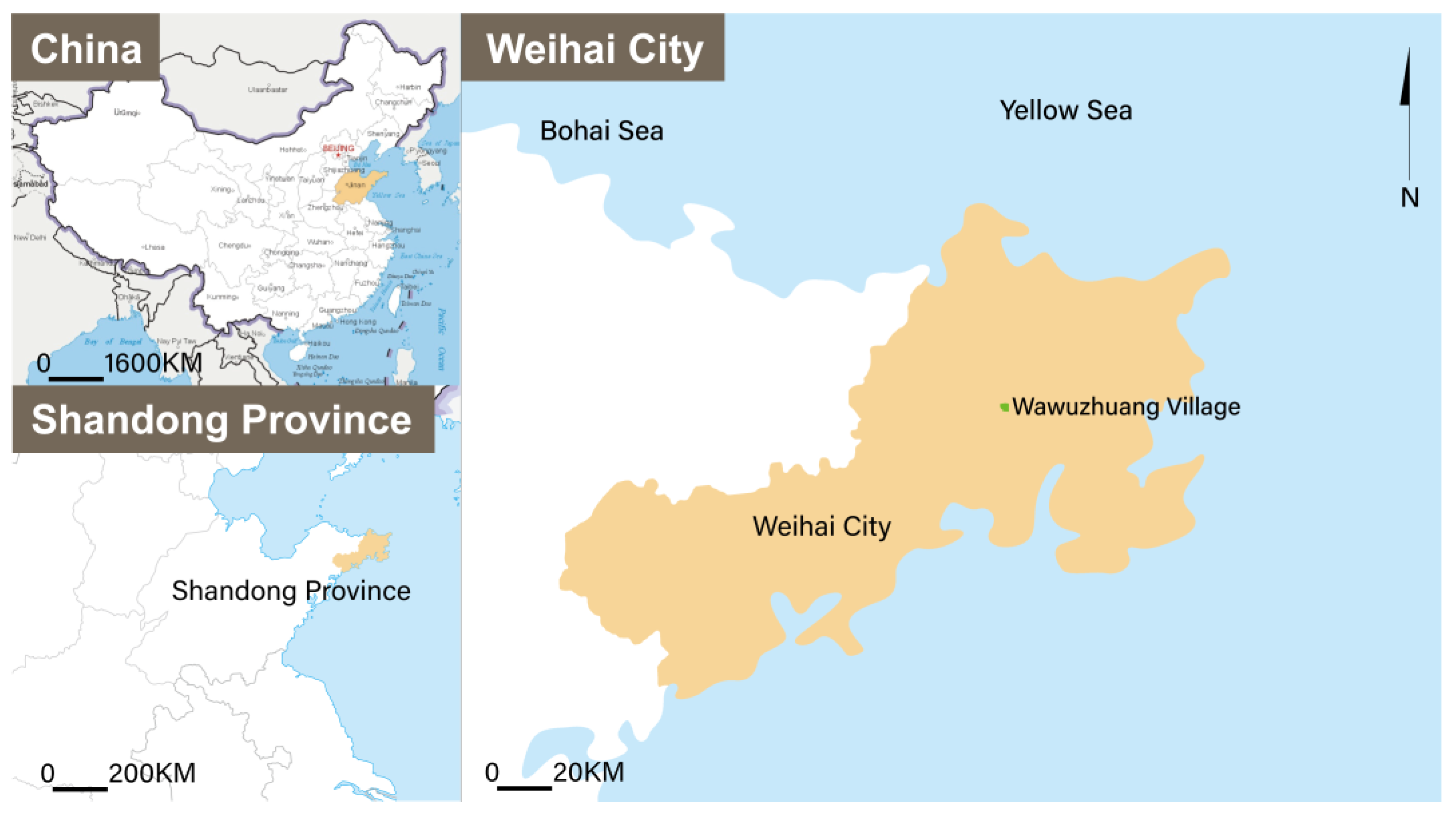
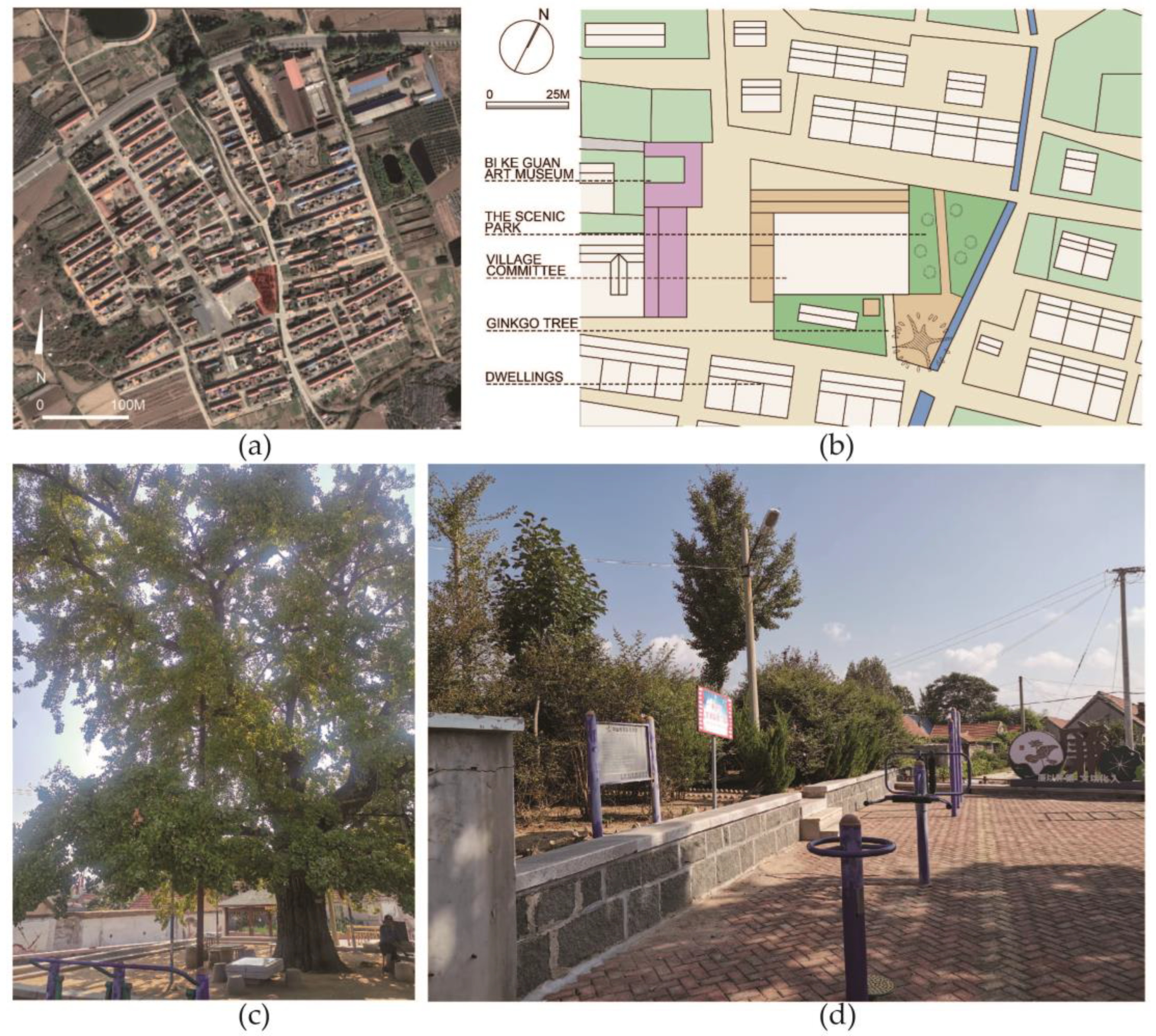
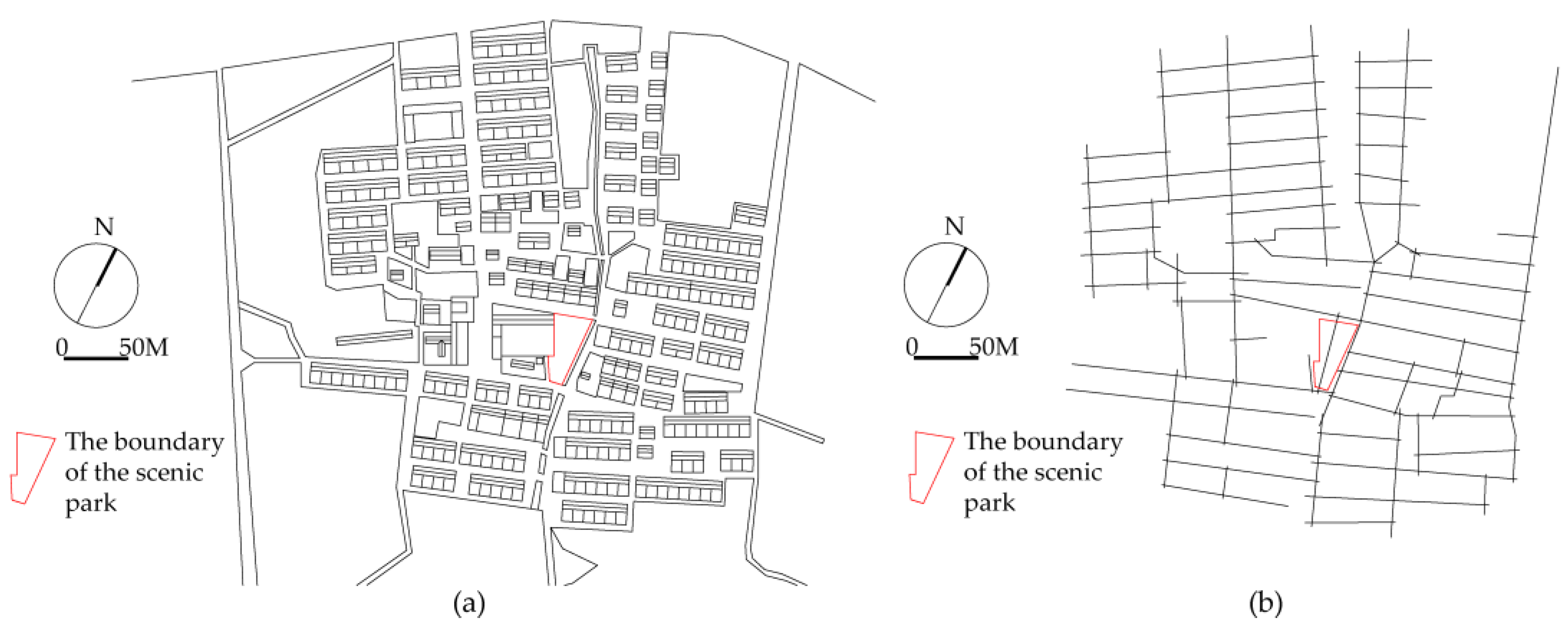
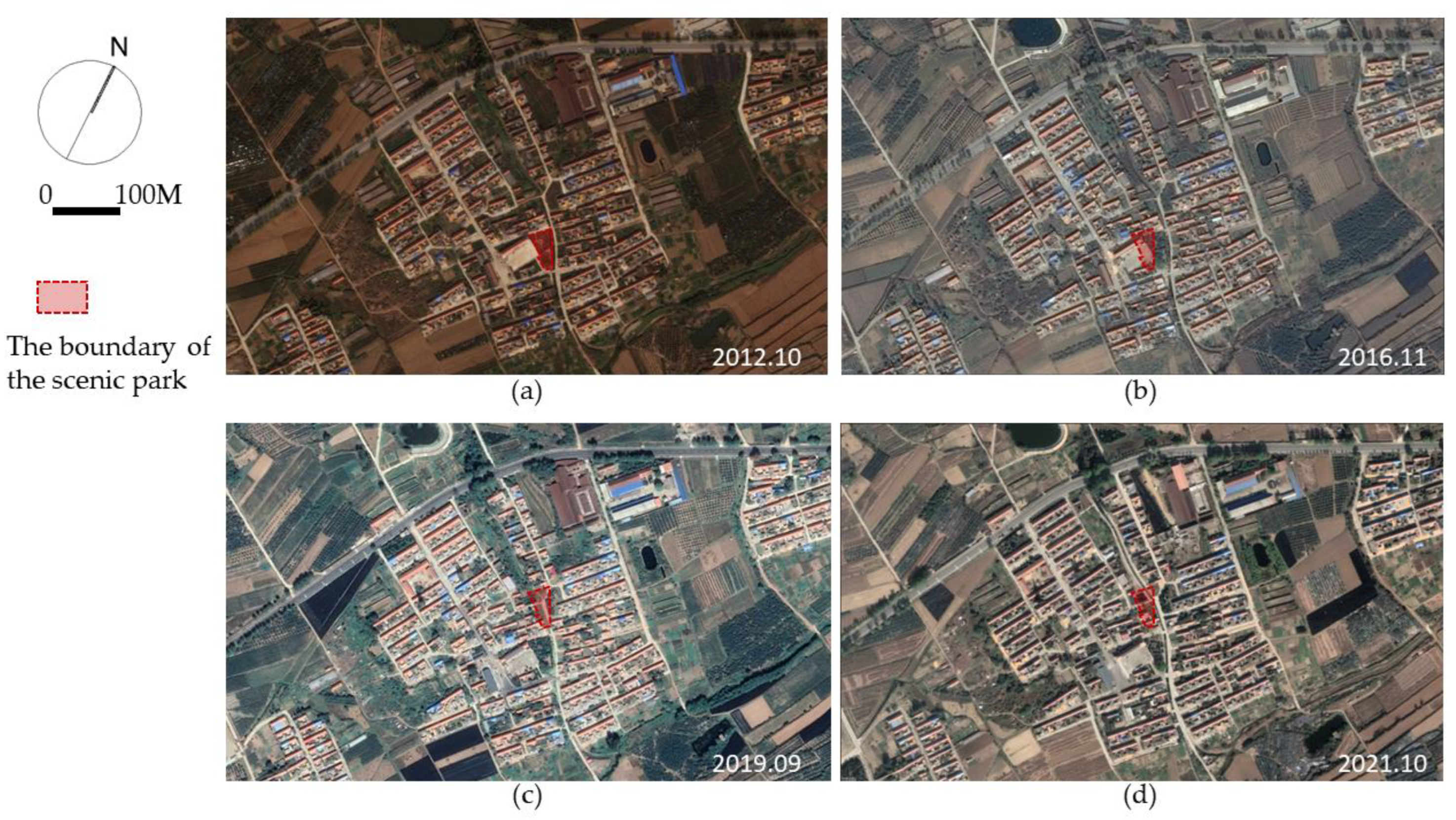
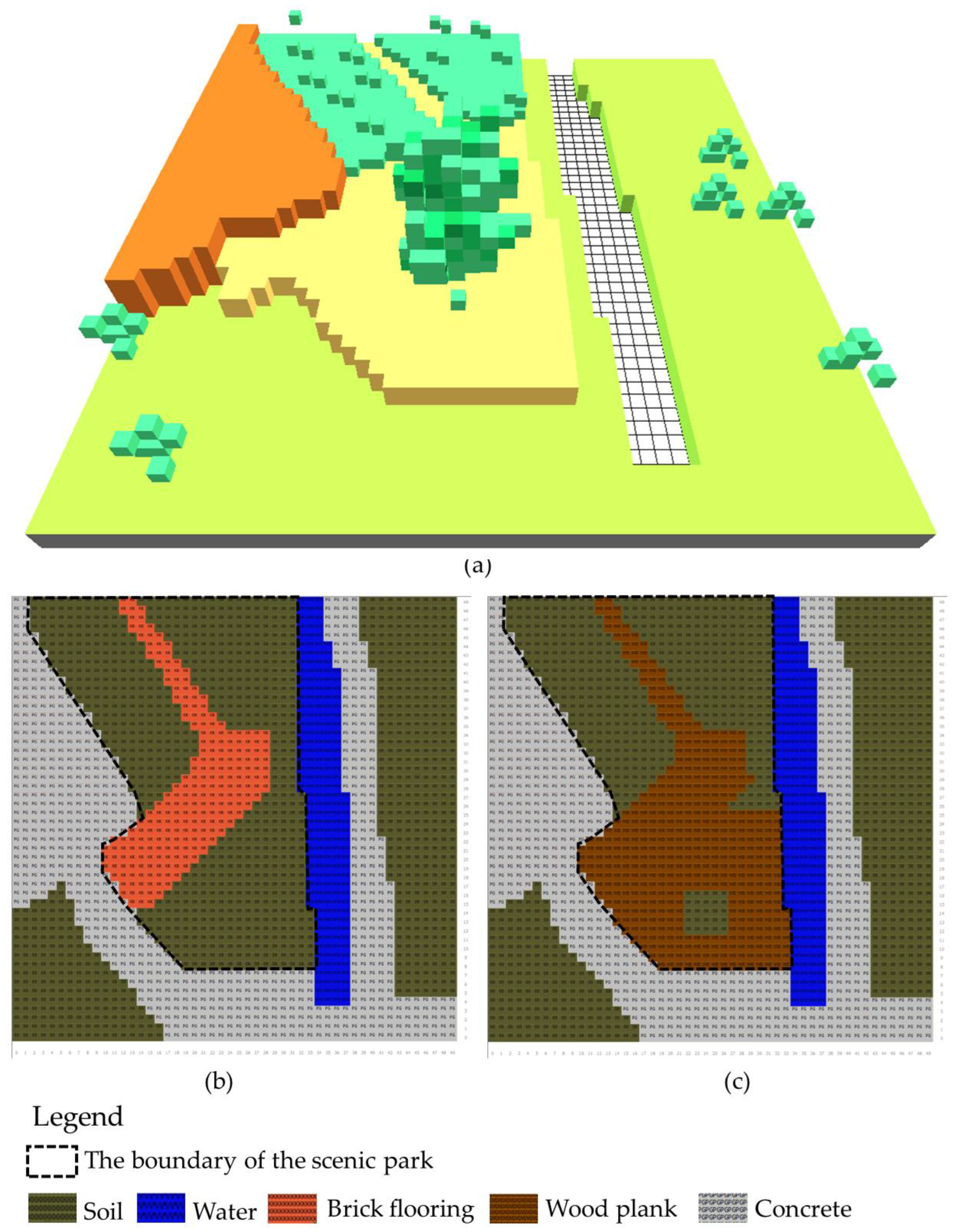

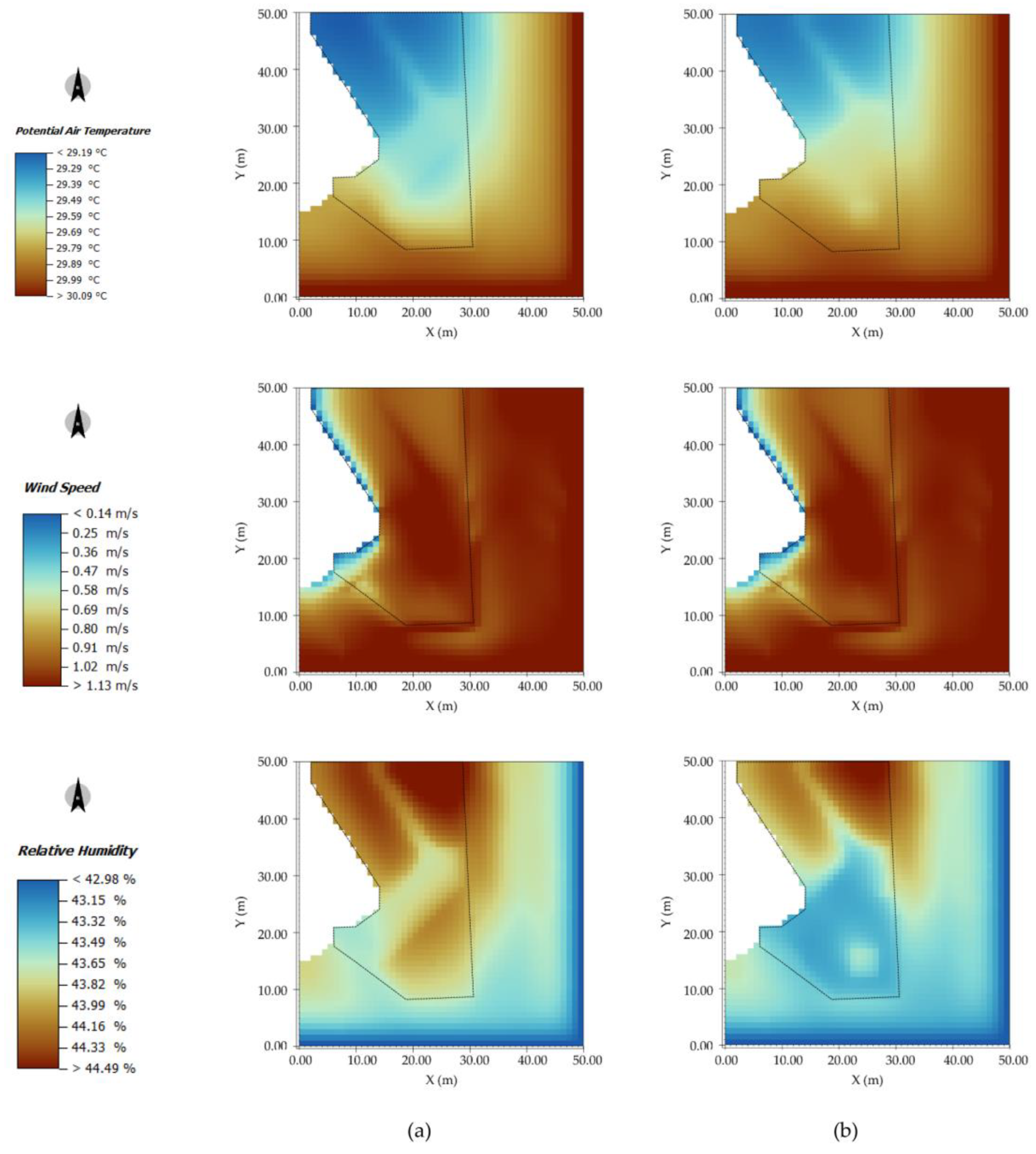
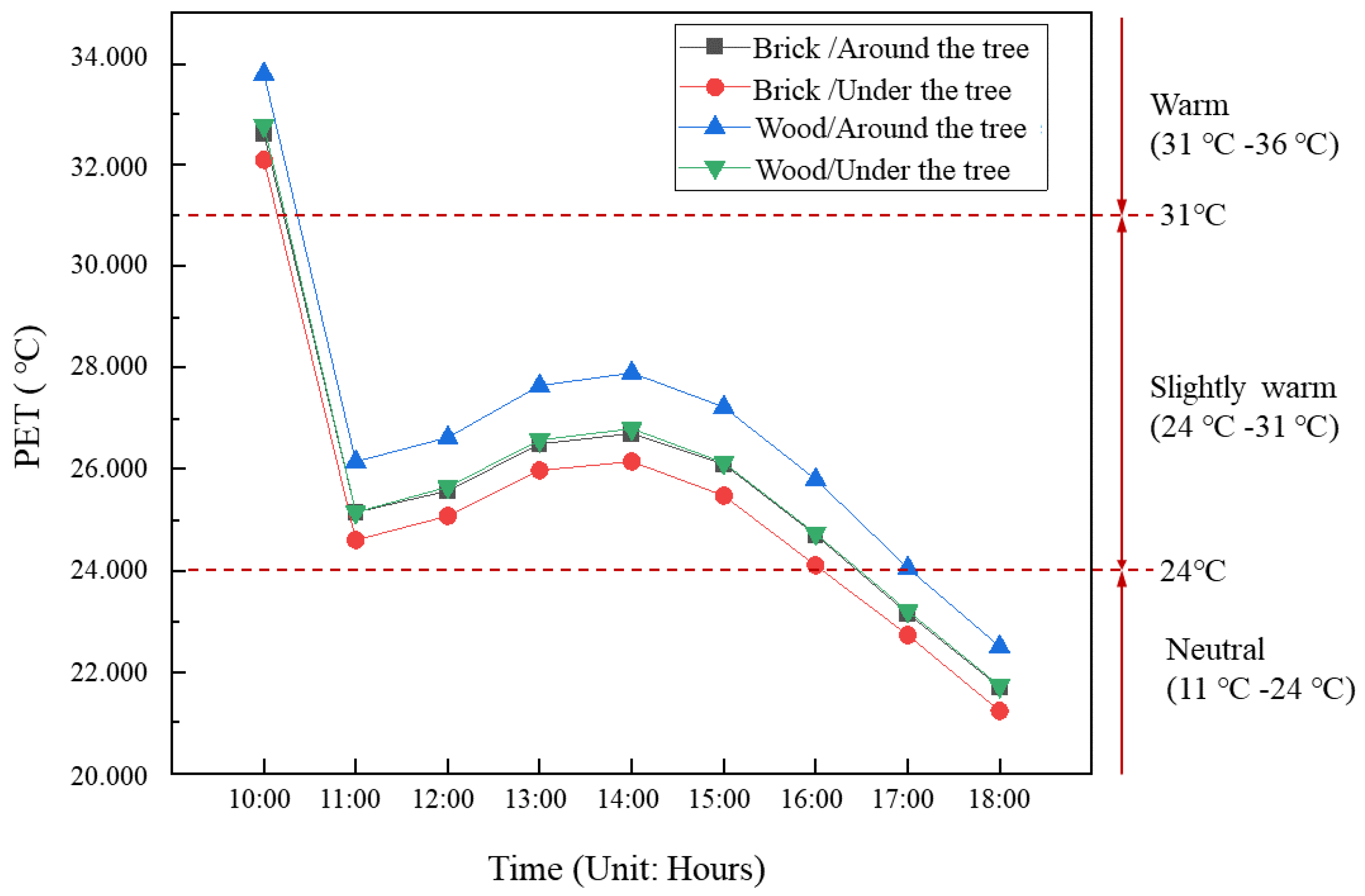
| Photo | Basic Concept | Main Form | Main User |
|---|---|---|---|
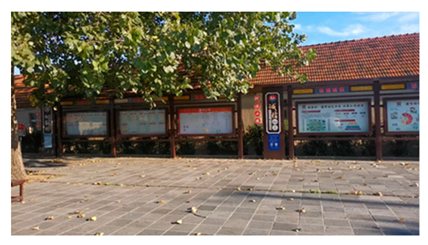 (a) Policy promotion park | A space mainly for the village committee to promote various policies. | Bulletin board, a small amount of greenery, brick, stone, or cement paving. | Village cadres and villagers for short-term use. |
 (b) Scenic park | A green space for relaxation, rest, and communication during daily life. | Seating, lawn and shade trees, and brick, stone, or cement paving. | Villagers, tourists. |
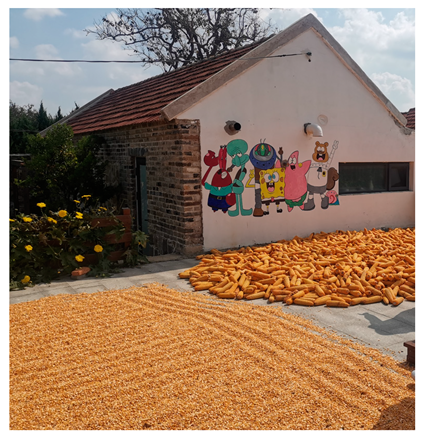 (c) Utilitarian park | A place for the villagers to temporarily store agricultural tools or dry grains. | Brick, stone, or cement paving. | Villagers engaged in agricultural activities. |
| All the photos were taken by the team during the field survey. | |||
| Individual Characteristics | Percent(%) | Frequency | |
|---|---|---|---|
| Gender | Male | 54.26 | 51 |
| Female | 45.74 | 43 | |
| Residence | City | 58.51 | 55 |
| Rural | 29.79 | 28 | |
| Urban–rural integration | 11.70 | 11 | |
| Education level | High/vocational below | 20.21 | 19 |
| High/vocational | 37.23 | 35 | |
| Bachelor | 38.30 | 36 | |
| Master’s and above | 4.26 | 4 | |
| Age group | 20 and below | 10.64 | 10 |
| 21–30 | 28.72 | 27 | |
| 31–40 | 34.04 | 32 | |
| 41–50 | 20.21 | 19 | |
| 51–60 | 4.26 | 4 | |
| 61 and above | 2.13 | 2 | |
| Visitor | Villager | ||||
|---|---|---|---|---|---|
| Individual Characteristics | Percent (%) | Frequency | Percent (%) | Frequency | |
| Gender | Male | 46.27 | 31 | 47.19 | 42 |
| Female | 53.73 | 36 | 52.81 | 47 | |
| Education level | High/vocational below | 13.43 | 9 | 57.30 | 51 |
| High/vocational | 25.37 | 17 | 26.97 | 24 | |
| Bachelor | 32.84 | 22 | 15.73 | 14 | |
| Master and above | 28.36 | 19 | - | - | |
| Age group | 20 and below | 16.42 | 11 | 4.49 | 4 |
| 21–30 | 25.37 | 17 | 5.62 | 5 | |
| 31–40 | 25.37 | 17 | 12.36 | 11 | |
| 41–50 | 14.93 | 10 | 22.47 | 20 | |
| 51–60 | 10.45 | 7 | 28.09 | 25 | |
| 61 and above | 7.46 | 5 | 26.97 | 24 | |
| Thermal Sensation | PET Range (°C) |
|---|---|
| Very cold | <−16 |
| Cold | −16 to −11 |
| Cool | −11 to −6 |
| Slightly cool | −6 to 11 |
| Neutral | 11 to 24 |
| Slightly warm | 24 to 31 |
| Warm | 31 to 36 |
| Hot | 36 to 46 |
| Very hot | >46 |
| Item | Average Value | TTL (Indicator Score) | Weight Value |
|---|---|---|---|
| Lawn and shade trees (1–5) | 3.68 | 1.50 | 33.33% |
| Seating (1–5) | 3.75 | 2.50 | 55.56% |
| Paving (1–5) | 3.48 | 0.50 | 11.11% |
| Evaluation Index | Visitor | Villager | ||||
|---|---|---|---|---|---|---|
| Mean | Weights | Satisfaction Level | Mean | Weights | Satisfaction Level | |
| Lawn and shade trees (1–5) | 4.16 | 33.33% | 3.93 | 33.33% | ||
| Seating (1–5) | 3.73 | 55.56% | 3.94 | 2.99 | 55.56% | 3.43 |
| Paving (1–5) | 4.31 | 11.11% | 4.12 | 11.11% | ||
| Brick Flooring | Wood Plank | |||||||
|---|---|---|---|---|---|---|---|---|
| Time | Around the Tree | Under the Tree | Around the Tree | Under the Tree | ||||
| 10:00 | 32.625 | Warm | 32.100 | Warm | 33.800 | Warm | 32.775 | Warm |
| 11:00 | 25.150 | Slightly warm | 24.600 | Slightly warm | 26.150 | Slightly warm | 25.150 | Slightly warm |
| 12:00 | 25.575 | Slightly warm | 25.075 | Slightly warm | 26.625 | Slightly warm | 25.650 | Slightly warm |
| 13:00 | 26.500 | Slightly warm | 25.975 | Slightly warm | 27.650 | Slightly warm | 26.575 | Slightly warm |
| 14:00 | 26.700 | Slightly warm | 26.150 | Slightly warm | 27.900 | Slightly warm | 26.800 | Slightly warm |
| 15:00 | 26.100 | Slightly warm | 25.475 | Slightly warm | 27.225 | Slightly warm | 26.125 | Slightly warm |
| 16:00 | 24.700 | Slightly warm | 24.100 | Slightly warm/Neutral | 25.800 | Slightly warm | 24.725 | Slightly warm |
| 17:00 | 23.150 | Neutral | 22.725 | Neutral | 24.050 | Slightly warm/Neutral | 23.200 | Neutral |
| 18:00 | 21.700 | Neutral | 21.225 | Neutral | 22.500 | Neutral | 21.725 | Neutral |
| Lawn | Shade Trees | Paving (Brick) | Soil | Seating | |
|---|---|---|---|---|---|
| Percentage | 36.75% | 18.15% | 39.86% | 13.65% | 3.21% |
Disclaimer/Publisher’s Note: The statements, opinions and data contained in all publications are solely those of the individual author(s) and contributor(s) and not of MDPI and/or the editor(s). MDPI and/or the editor(s) disclaim responsibility for any injury to people or property resulting from any ideas, methods, instructions or products referred to in the content. |
© 2024 by the authors. Licensee MDPI, Basel, Switzerland. This article is an open access article distributed under the terms and conditions of the Creative Commons Attribution (CC BY) license (https://creativecommons.org/licenses/by/4.0/).
Share and Cite
Yao, W.; Zhang, T.; Fukuda, H.; Wang, M.; Yang, J. Assessing Utilization and Comfort in a Village Scenic Park: Implications for Rural Revitalization. Buildings 2024, 14, 1538. https://doi.org/10.3390/buildings14061538
Yao W, Zhang T, Fukuda H, Wang M, Yang J. Assessing Utilization and Comfort in a Village Scenic Park: Implications for Rural Revitalization. Buildings. 2024; 14(6):1538. https://doi.org/10.3390/buildings14061538
Chicago/Turabian StyleYao, Wenying, Tao Zhang, Hiroatsu Fukuda, Mengying Wang, and Jinli Yang. 2024. "Assessing Utilization and Comfort in a Village Scenic Park: Implications for Rural Revitalization" Buildings 14, no. 6: 1538. https://doi.org/10.3390/buildings14061538
APA StyleYao, W., Zhang, T., Fukuda, H., Wang, M., & Yang, J. (2024). Assessing Utilization and Comfort in a Village Scenic Park: Implications for Rural Revitalization. Buildings, 14(6), 1538. https://doi.org/10.3390/buildings14061538







